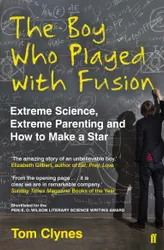The Boy Who Played With Fusion follows the story of Taylor Wilson, and his family, as he navigates school and life as a science prodigy. He starts out being interested in chemistry and the impressive explosions he can make before becoming fascinated by radioactivity and nuclear physics. He collects radioactive samples, and eventually sets out to make a fusor, which is a type of nuclear reactor that can fuse atoms together. His parents, who do not have a science background, give him a lot of freedom to develop his talents, but also try to keep him safe and make sure he has the support he needs while working with radioactive materials. The author includes himself in the story, following Taylor on his prospecting trips, and visiting the labs where he conducts his experiments and builds his devices. Often the author and Taylor’s parents seem to be being dragged along by Taylor’s enthusiasm for science.
As the book progresses, the author discusses the role that parents and teachers play in the development of gifted and super-intelligent children, and how these children can be prevented from reaching their full potential by the educational system and parents who aren’t able to support their talented offspring. It also discusses the issue of whether it’s elitist to send gifted children to special schools to help them maximise their talents, whether it’s better to focus on bringing all children up to a decent level instead, or whether we can do both. An interesting side-story in the book is Taylor’s brother, Joey. He seems to be a maths prodigy, but shuns the limelight that Taylor craves, and the book explores how the brothers and sisters (brilliant or otherwise) of gifted children are affected by their sibling’s achievements and attention.
Taylor is a practical scientist. He learns enough theory to get by, but he’s really interested in building and tinkering to get things working. He’s also gifted in talking about his work, and throughout the book he wins over many experienced scientists who start out viewing him as just an enthusiastic boy. After talking with him for a while they come to regard him as an equal, and he gains several collaborators who help him to further his projects. There is quite a lot of science in this book too, and I really enjoyed the details of the engineering and design work that went into Taylor’s inventions. There are several photographs in the middle of the book, including Taylor with some of his inventions.
I really enjoyed this book. Taylor is an extraordinary character right from the start of the book when he is 9 years old, and is teaching his class in school. But he continues to develop thoughout the book as he expands his abilities in nuclear physics. By the end he is winning science contests, doing TED talks, meeting the US President, and getting investors interested in his ideas. There is a moment where the constant attention and adoration might be having a negative effect on his personality. But mostly Taylor comes across as a happy, enthusiastic person who is completely driven by curiosity and the desire to understand science and make things.
This book was published a few years ago, so I tried to look up what Taylor has been up to since it was published. But his website has a lot of under construction pages, and there isn’t much on Wikipedia about what he’s done since the book was published. I really hope he’s continued to build cool things!
